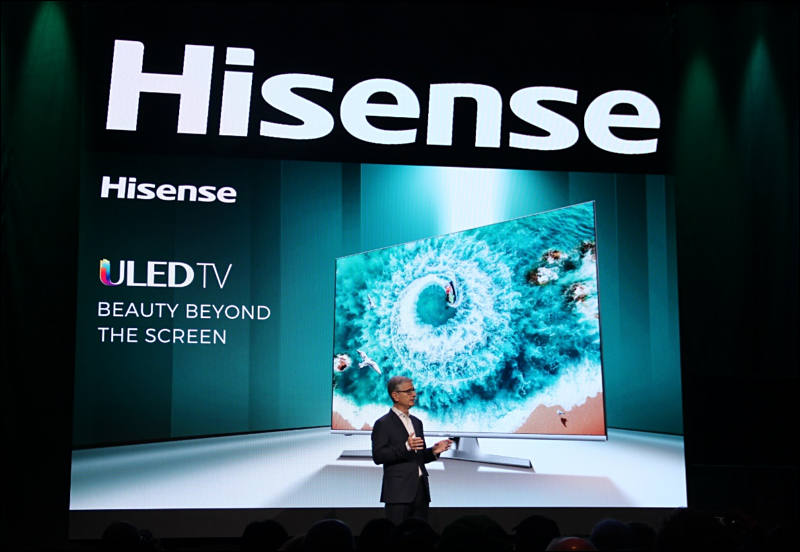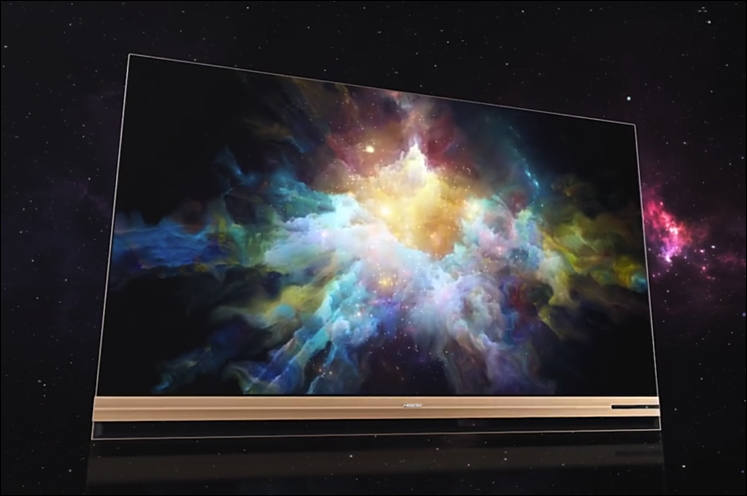
-
Hisense uses Dual-cell ULED XD panel layer that puts a 1080p module displaying a grayscale image between a full array LED backlight and a 4K module. Panel has 2,900 nits peak brightness.
Also they have 512 direct led backlight zones.
Prototype used 65-inch VA panel. With peak brightness as we told above at 2900 cd/m² and a black at 0.0018 cd/m² we have real contrast ratio greater than 200 000:1. In EU and US most probably it'll be only in 2020.

Actually this guys matched top reference monitors approach - check our interview about such http://www.personal-view.com/talks/discussion/20797/nab-ny-2018-flanders-scientific-xm311k-hdr-reference-monitor#Item_1
Such layer has 3000:1 to 5000:1 contrast, so combined it is staggering numbers, as in real room black level will reach OLED, and not in the large zones as usual, with brightness reading top Samsung sets.
Check our interview below.
-
The HZ65U9E has been out for a while (the Chinese variant) and there's been a few reviews on that.
The H65U9X, on the other hand, looks phenomenal, using QLED technology to provide 1500 nits of peak brightness with .00003 nits of minimal brightness, or in other words, a potential contrast ratio of 50,000,000.
To note, for people who do photography, the .00003 nits of minimal brightness is equivalent to EV -14.65 (note EV is log2x in form, so +1 EV is a doubling of light value). Astrophotography of the Milky Way Galactic Center is -9 to -11 EV, and photography under starlight only (no city lights or light pollution) is -6 EV.
-
Biggest HDR hurdle now are... energy limits placed by EU and US bureaucrats. :-)
All this "peak brightness" come exactly from idea to avoid energy limits.
As for cooling - it is absolutely not issue if done right. Under done right I mean good aluminum back contacting via thermal paste with leds and with good heatsink like construction on other side. Such thing for 32-40" can bear 400-500w without problem.
This also mean that idea to make separate led panels, as it is done now is not good idea. HDR panels must be one with all outer metal parts.
-
Panel tech is rapidly improving. My LG OLED was a revelation, not only for the perfect black levels, but the color accuracy is incredible. The increased local contrast also gives the impression of much greater sharpness - I can see details that aren’t visible on my 5K iMac. Black levels on the iMac are a weak .5 nits, just a dull grey: while OLED blacks are below .0005 nits.
I ordered the Asus ProArt 32UCX as an HDR grading monitor - 55” is too large for me to work comfortably in a small room, so using the television as a monitor is out of the question, though high end studios use them.
The Asus has 1,152 local dimming zones and 1,400 nits brightness, 700 nits more than my television set! By way of comparison, your average movie theater screen is somewhere in the neighborhood of 50 nits. On an SDR display, sunlight glaring off of the hood of a waxed automobile is reproduced as exactly the same brightness as a white sheet of paper. When 10,000 nit televisions are commonplace, I imagine viewers will squint when seeing bright flashes of light in a darkened room.
A problem with these high brightness LEDs with FALD is they draw a ton of power: I believe mine uses as much as 220 watts; they require efficient cooling, which I’m assuming accounts for the noise. It isn’t just that the monitor is expensive: it requires a $1,000 i/o device to work with a Mac. At the same time, it was only a couple years ago that Mystery Box was recommending the $3,700 SmallHD P3X, a 17” HD monitor, as a ‘budget’ solution to HDR grading.
A couple of weeks ago, it was announced that Netflix is now requiring all productions be shot in HDR. As they already dictate only log or RAW for capture - which are already HDR - I’m guessing this pertains to production design and lighting (?), but not really sure, and I don’t understand how that could be regulated. The original Chef’s Table is one example of outstanding cinematography combined with HDR.
-
Issue with OLED is real brightness it can withstand, tests show that it is around 400-500nits long term real use or 600-700nits peak short term.
All OLEDs degrade, 100%. Slowly changing color reproduction.
I think Hisense ULED XD slowing down is related to trade war, as such sets require biggest markets to be available.
Apple will also rumored to use similar tech with lot of microleds in backlight and real 1500-2000nits of peak brightness.
-
The end of 2019 is near, and I have yet to see any independent test of one of those "Hisense ULED XD" TVs announced for this year in July. Looks like not even samples have made it into the hands of journalists. Similar, no "Panasonic Megacon" samples showed up in any tester's hand.
Meanwhile, even Samsung has stated in public to jump on the OLED bandwagon, as did Xiaomi, recently. And my 2015 LG 4k OLED TV still runs perfectly fine, with no visible "burn-in".
-
Image retention is BIG problem for monitor used, all leading manufacturers and press made long time tests.
-
Do you have a specific link to a product from Flanders Scientific using two LCDs? (I saw many different kinds of monitors on their web page, but no obvious hints to the use of two LCDs.)
Generally I'm not sold on the idea that "two LCDs" will outcompete OLEDs for consumer displays. I'm happily running a LG 4k OLED TV since 2015, both for movies and as a computer monitor, and "image retention" hasn't ever been a problem for me. The early model near-black uniformity issues have been sorted out in contemporary OLED TVs.
I'm curious to see a Hisense ULED XD tested e.g. at https://www.rtings.com/tv/reviews/hisense - until then, I remain skeptic about this approach.
-
If you do account for reflections of ambient light at the display surface, then the achievable contrast ratio mainly depends on your surface coating/structure, and that is independent from the display technology behind it.
Well, no. It depends on display tech a lot.
Also, I am still missing a plausible description of how they manage to combine the filtering effects of two LCDs in front of the light source. After all, LCDs are based on modulating polarization, and if you put two similar polarization filters in the path of your light, their effect does not simply add up (or better: multiply).
You can check how Flanders Scientific are doing the same thing.
Their top reference monitors are made exactly such.
And unfortunately for OLED, due to it's unsolvable problems, it will be mainstream way for consumer TVs also.
Progress with backlight brightness and processors solve all the issues cheap.
Poor manufacturers now have their main enemy - government who in their stupidity made wrong consumption limits on TVs, especially EU is known for this.
-
"A contrast ratio of over 150,000, exceeding OLEDs" is clearly a marketing lie. If you do not account for reflections of ambient light at the display surface, then contrast ratios of OLEDs are infinite, because black is black with them. If you do account for reflections of ambient light at the display surface, then the achievable contrast ratio mainly depends on your surface coating/structure, and that is independent from the display technology behind it.
Also, I am still missing a plausible description of how they manage to combine the filtering effects of two LCDs in front of the light source. After all, LCDs are based on modulating polarization, and if you put two similar polarization filters in the path of your light, their effect does not simply add up (or better: multiply).
I think we need to wait for independent lab reviews before concluding that this is a real revolution :-)
-
Thing is launching finally.

Display technology was manufactured in partnership with BOE and is called BD Cell. Hisense says it is proud the technology is fully Chinese.
The display consists of two panels – a color panel which focuses on color control and the black and white panel which handles dimming, contrast, and details. There are also five chips inside the TV that efficiently control the backlight and images. Combined with the dual panels, the U9E has a contrast ratio of over 150,000, exceeding OLEDs; and a picture quality is outstanding.
The Hisense U9e is also said to exceed the peak brightness, color gamut, color accuracy and HDR certification requirements of OLED TVs.
The U9e will come in 55-inch, 65-inch, and 75-inch models. Only the 65-inch model is available this year at a price of ¥17,999 (~$2616), making it even more expensive than Sony’s 65-inch LCD TV for 2019. The 55-inch and 75-inch models will be available next year. Hisense didn’t reveal when the 55-inch model will be available for purchase.
One strange thing is that 75 U9E at some expos had been mentioned as having 5376 Local Dimming zones, that is really small for such tech.
-
Too thick, plus OLED is more energy efficient.
-
Works for cell phones too? Or too much energy?
Howdy, Stranger!
It looks like you're new here. If you want to get involved, click one of these buttons!
Categories
- Topics List24,071
- Blog5,725
- General and News1,392
- Hacks and Patches1,153
- ↳ Top Settings33
- ↳ Beginners256
- ↳ Archives402
- ↳ Hacks News and Development56
- Cameras2,391
- ↳ Panasonic995
- ↳ Canon118
- ↳ Sony156
- ↳ Nikon96
- ↳ Pentax and Samsung70
- ↳ Olympus and Fujifilm102
- ↳ Compacts and Camcorders300
- ↳ Smartphones for video97
- ↳ Pro Video Cameras191
- ↳ BlackMagic and other raw cameras139
- Skill1,960
- ↳ Business and distribution66
- ↳ Preparation, scripts and legal38
- ↳ Art149
- ↳ Import, Convert, Exporting291
- ↳ Editors191
- ↳ Effects and stunts115
- ↳ Color grading197
- ↳ Sound and Music280
- ↳ Lighting96
- ↳ Software and storage tips266
- Gear5,420
- ↳ Filters, Adapters, Matte boxes344
- ↳ Lenses1,582
- ↳ Follow focus and gears93
- ↳ Sound499
- ↳ Lighting gear314
- ↳ Camera movement230
- ↳ Gimbals and copters302
- ↳ Rigs and related stuff273
- ↳ Power solutions83
- ↳ Monitors and viewfinders340
- ↳ Tripods and fluid heads139
- ↳ Storage286
- ↳ Computers and studio gear560
- ↳ VR and 3D248
- Showcase1,859
- Marketplace2,834
- Offtopic1,337







